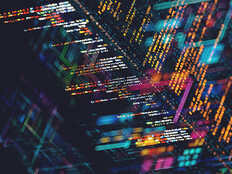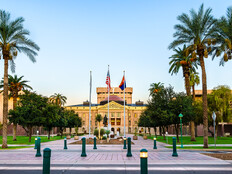Cool, Green Glow
There’s no question that green initiatives have captured the spotlight.
“There are clearly cost savings and environmental gains,” says Steve Reneker, chief information officer for the city of Riverside, Calif. “But there is also a huge social benefit. We want to make Riverside a smarter city and improve the quality of life.”
Like Riverside, which has many green computing initiatives, other state and local governments are building on work begun by the Environmental Protection Agency’s Energy Star program. The focus turns on reaping gains through smart information technology use. Consider North Carolina’s State Energy Office, and its director, Larry Shirley, who says, “Managing computer energy is a high priority of our work with state agencies and universities.”
The EPA, which launched the Energy Star program in 1992 to generate savings in electricity and fossil fuel costs, specifies energy-efficient standards for computers and other types of equipment. As a result, an inactive computer that slips into low-power mode today draws 15 watts of electricity or less, compared with hundreds of watts when fully active.
Beyond merely buying systems bearing the Energy Star designation, North Carolina’s State Energy Office encourages the use of software to power down computers and monitors when they’re idle — and ensure that they harness power-saving features when in use. The program is part of a statewide effort, the Utility Savings Initiative, which aims to reduce energy costs by 20 percent across all state agencies, public universities and community colleges during the next five years.
 “Energy conservation and environmental sensitivity are issues that government cannot ignore,” says Steve Reneker, CIO of Riverside, Calif.
“Energy conservation and environmental sensitivity are issues that government cannot ignore,” says Steve Reneker, CIO of Riverside, Calif.
A Long Horizon
The city of Riverside wants to extend its efforts, too. Reneker says he hopes to create a green oasis in the desert community. These days, he’s pushing energy-efficient PCs, electronics recycling and server virtualization to trim costs and improve the environment. “Energy conservation and environmental sensitivity are issues that government cannot ignore,” he says. “We’re hoping to put Riverside at the forefront of the green movement within government.”
The city turned to virtualization and consolidation to lessen demands on data center space — making it possible to reclaim part of a building and set up a network operations center. This helped Riverside avoid additional investments in real estate, Reneker says. During the past year, the city of 290,000 slashed the number of servers in use from 220 to 160. This has led to hardware savings of $1.5 million per year and a reduction of thousands of dollars in energy expenses.
“We are constantly looking for a way to improve the efficiency of our data center and cut costs,” Reneker says.
But maximizing the efficiency of its servers and reining in its IT footprint does not tell the city’s entire green story. The city also oversees a refurbishing and recycling program that diverts PCs from landfills and relies on power management software to reduce electrical consumption.
The recycling program combines green with social good, says Reneker. Overall, the Riverside government runs more than 2,300 computers that it refreshes every three years. Through the recycling program, the city offloads approximately 750 PCs annually. It also asks residents to donate working and nonworking computers that are then recycled, either by former gang members who refurbish and donate them to low-income households through the nonprofit SmartRiverside organization, or by a certified recycling firm through a partnership with the state.
“We believe that this program offers positive benefits for everyone involved,” Reneker says. Money earned through the recycling program is directed into the SmartRiverside program, which refurbishes approximately 5,000 PCs annually.
Concerned that surplus state computers auctioned to the public will end up in the general waste stream, the state of Indiana this summer will begin sending surplus computers to PEN Products, or Prison Enterprise Network, a division of the Indiana Department of Corrections. There, prisoners will wipe the hard drives and recover metals and plastics that can be used in the recycling market. Portions of the PCs that can’t be recycled will be disposed of in an environmentally friendly manner, according to Elizabeth Barrett, communications manager for the Indiana Department of Administration.
I.T. Products and Solutions for a Greener Environment
- PCs and Macs: Most desktop and notebook systems offer energy-saving features, including sleep and hibernation modes that power down disk drives and other components when they’re not in use.
- Displays: LCDs are 30 percent to 50 percent more energy efficient than CRT computer display screens. Users can program Energy Star monitors to automatically shift to a low-power mode when not in use.
- Printers and peripherals: Energy Star printers, scanners and multifunctional devices slip into a power-saving mode when not in use. They’re 25 percent more energy-efficient than conventional models.
- Copiers and fax machines: These devices with Energy Star designations can power down when not in use and are one-third more efficient than conventional equipment. External power adapters. Energy Star power supplies or battery chargers — used with digital cameras, MP3 players, routers, telephones, personal digital assistants and other devices — use approximately one-third less energy than other models.
- Virtualization and consolidation: Dividing servers into multiple virtual machines that partition applications can increase server utilization rates and shrink the total number of servers needed when consolidating systems.
Green Tide
Riverside isn’t alone. During the past decade, green initiatives have begun to flourish. As landfills have run out of space, energy costs have risen, data centers have become more expensive to operate and a growing awareness of environmental problems has taken root, says Chris Dixon, manager of state and local market analysis for Input, a consulting firm in Reston, Va. Many businesses and government agencies have responded with programs to help manage resources more effectively. At the center of this trend: green computing.
“There’s a growing recognition that environmental issues are here to stay and that government must be part of the solution,” Dixon says.
According to Adam Braunstein, principal analyst and director of end-user computing strategies at Robert Frances Group, a Westport, Conn.-based IT consulting firm, businesses and government organizations until recently often neglected the potential for combining green strategies with its PC refresh and end-of-life strategies. Many organizations “overlook and/or underestimate the costs associated with retiring and disposing of PCs,” he says.
These costs include recycling but also the removal of sensitive data and the ability to conform to a growing array of regulatory requirements, including the disposal of toxic substances, such as lead and mercury. Yet, end-of-life issues aren’t only a monetary matter; they also encompass risk and liability concerns, Braunstein points out.
“We are seeing a push among government agencies to become environmentally conscious,” he says. “The poster child of this green movement is the PC. It’s on everyone’s desktop; everyone understands how it works; and everyone recognizes that it has a lifecycle. Growing regulatory requirements and political pressure are forcing organizations to take action.”
The state of Delaware, for example, will incorporate environmentally friendly features into the design of its new primary data center. “Not only is it the right thing to do, but it will help with our ongoing operating costs,” says Bill Hickox, chief operating officer for the state’s Department of Technology and Information. “It is specifically our intention to design something and construct something that has a green aspect to it.”
With construction of the data center slated to begin next year, technologies on the drawing board include heat transference to pull heat out of certain areas, virtualization and blade servers. Hickox notes architects have also discussed landscaping the roof of the data center to provide a barrier from the heat in the summer and insulation from the cold in the winter.
Manufacturers, too, are taking notice. Some vendors, including Cisco Systems, Hewlett-Packard and Sun Microsystems, offer reuse and recycle programs. HP, for example, has established a goal of recycling 1 billion pounds of electronics products and supplies by the end of the year. Between 1987 and the end of 2006, it had recycled more than 920 million pounds of electronics. The company also has introduced HP Dynamic Smart Cooling, a technology to monitor and retune cooling systems to provide maximum data center efficiency. HP claims that Dyanmic Smart Cooling can cut cooling costs by 25 percent to 40 percent.
Meanwhile, Cisco has consolidated its green initiatives under one umbrella, Eco Board, which aims to reduce carbon dioxide emissions and toxic waste. And Sun Microsystems’ Sun Eco program targets power consumption in servers and data centers. Sun also offers calculators and tools that measure the impact of servers and data center power consumption, so buyers can be better informed about making energy-efficient purchases.
Other Environmentally Friendly Hues: Bronze, Silver and Gold
Going green might make sense but knowing how and where to save dollars can prove vexing — particularly with hundreds of end-user systems, servers and monitors available at any given moment. A source of help is the Electronic Product Environmental Assessment Tool, or EPEAT, which guides buyers through the selection process using a set of performance criteria revolving around product design and power consumption.
The EPEAT Web site, www.epeat.net, offers a registry of products that conform to environmental performance standards for electronics products, from IEEE 1680 through IEEE 2006. Depending on the level of energy efficiency and the number of option criteria that products meet on the EPEAT ratings, they are awarded a bronze, silver or gold certification accordingly.
As of early spring, 426 desktop systems, monitors and notebooks had bronze certification, 375 met the silver standard and none had achieved gold. Yet, EPEAT ratings are gaining prominence and importance among government agencies and vendors. Hewlett-Packard, Lenovo, Panasonic, Sony and Toshiba brands are listed among the electronics products that have been ranked by EPEAT.
In January, President Bush signed an executive order that requires federal agencies to buy EPEAT-registered products, as well as other green devices. A growing number of state and local governments are also using the registry to drive green buying.
Matthew Lampe, Chief Technology Officer for the city of Portland, Ore., adopted stringent computer buying criteria to address green IT initiatives.
From the Get-Go
Some state and local governments carefully weigh green criteria before they buy servers and PCs. The city of Portland, Ore., introduced a strategic sourcing program in 2005. “We wanted to find a way to make PC purchases and end-of-life issues a central part of a green initiative,” says Chief Technology Officer Matthew Lampe.
Portland developed a list of 20 criteria that it applies when making buying decisions, including end-of-life disposal, packaging reduction and handling of hazardous materials. How a vendor meets these criteria accounts for approximately 10 percent of the overall score. “Some purchases have been decided by the criteria,” he adds.
The city, which buys more than 1,000 computers annually, has made providing that information a threshold requirement: Provide it or don’t bid. Portland plans to re-evaluate and update its process every few years. In the next iteration, it plans to add support for European Union initiatives, such as the Restriction of Hazardous Substances and Waste Electrical and Electronic Equipment directives.
“The situation is constantly changing and evolving, and it’s important to stay current,” Lampe says. “Most manufacturers are aggressive about selling computers, so they take these evaluations seriously.”
For Portland, the criteria are more than lip service. Manufacturers sign an agreement with the city guaranteeing that they will dispose of systems properly, for instance. The city also donates working systems to nonprofit and educational organizations and requires that these organizations also use end-of-life procedures that maximize recycling and minimize toxic waste. Portland’s goal is to find vendors that will serve as strategic partners and that “share our values on the importance of being green — in addition to helping us improve service and save money for the city,” Lampe says.
Although Portland is in the vanguard, analysts Dixon and Braunstein expect that’s likely to change in the months ahead. As government CIOs and IT executives recognize the value of consolidating and managing data centers, establishing power management profiles on PCs, managing electronics recycling and disposal, and confronting public demand for more energy-efficient systems, green computing will flourish, they say.
For now though, Dixon says, green programs still have a way to go in state and local government organizations. “Although many government agencies are feeling growing public pressure and they’re looking for ways to cut costs, many of them haven’t progressed far along the environmental continuum. They’ve mostly realized the benefits of the Energy Star program and lower power consumption from LCD displays.”
Indeed, some state and local governments that aren’t specifically focused on green computing are already using energy-efficient technologies, notes Thom Rubel, practice director of government programs for IDC research firm Government Insights in Falls Church, Va. “The general movement going on there is being driven by costs. There’s a big convergence when you talk about blades, data centers and virtualization to be smart about how you use IT and that has an impact on green.”
Rising Star
Despite the initial skepticism of the Energy Star program, the voluntary measures issued by the Environmental Protection Agency are compelling.
Besides reducing energy consumption, EPA estimates that the use of Energy Star appliances, including computers and other office equipment, have prevented 37 million tons of greenhouse gas emissions — equivalent to the amount of exhaust produced by 25 million cars.
Not surprisingly, EPA continues to fine-tune Energy Star as environmental awareness and a desire to cut costs evolve. In 2006, the agency updated Energy Star specifications for computers and imaging equipment to address active power consumption. This summer, EPA will officially issue version 4.0 of the program’s IT specifications. The first major change for computing devices in 15 years, the new specifications will have two tiers:
- Tier 1 will require that 80 percent of incoming electricity be used by a PC’s power supply. It will also require an idle PC to draw 50 watts or less.
- Tier 2, which is scheduled for implementation by July 2009, will offer additional energy-saving specifications for computers and equipment, such as LCDs and flat-screen monitors. EPA expects that many of these devices will take advantage of energy consumption improvements available through new microprocessors.








